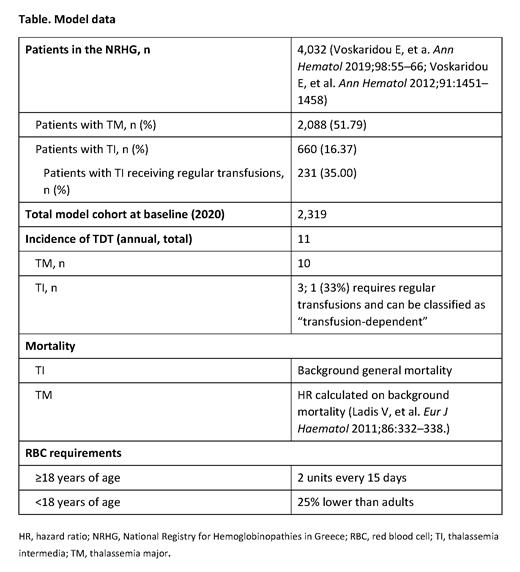Abstract
Introduction: In Greece, official data confirm that blood supply is consistently declining, primarily because of decreased voluntary blood donations. At this rate, it is unclear whether there will be sufficient red blood cell (RBC) units to meet future demand for patients with β-thalassemia. We modeled future blood demand in patients with transfusion-dependent β-thalassemia (TDT) over the next 15 years to assess whether such a demand can be met.
Methods: A discrete time, stochastic, individual-based model, was developed to assess future blood needs of patients with TDT in Greece. The model adopted a cohort approach and patients enter the model shortly after birth and exit at death. The model was seeded with data from the National Registry for Hemoglobinopathies in Greece (NRHG; patient population) and data from the National Blood Centre (RBC units) (Table). To quantify the decrease in TDT incidence, a linear regression model was fitted to the incident cases as described by Voskaridou (Voskaridou E, et al. Ann Hematol 2019;98:55-66). The calculated annual reduction rate was then applied to the observed thalassemia major (TM) and thalassemia intermedia (TI) incident cases for 2012 (Voskaridou E, et al. Ann Hematol 2012;91:1451-1458). The model assumes the reduction would continue through to 2020, from which time the incidence curve would be constant.
Results: The model estimates a decrease in both target population, primarily due to the implementation of the national prenatal screening program and TM related mortality, (9.2%, 18.6%, and 26.0% in 2025, 2030, and 2034, respectively) and in demand for RBC units (100,665, 89,428 and 80,565, respectively) over the next 15 years. After accounting for any blood donated, based on latest (2017) data as projected to 2020, Greece is expected to be short of 56,716 RBC units to meet needs of patients with TDT in 2020. By 2025, 2030, and 2034, cumulative required RBC units for patients with TDT are estimated to be 307,150, 501,698, and 617,074, respectively. Assuming RBC units are divided among patients ≥ 18 years and those < 18 years in line with the population mix in the NRHG, cumulative RBC units required for adult patients with TDT are estimated to be 292,837, 464,337, and 554,083 by 2025, 2030, and 2034, respectively.
Conclusions: Though blood demand for patients with TDT is expected to decrease in line with a decrease in the patient population, it will remain a challenge for the healthcare system in Greece to meet the demand, primarily due to a continuing shortage of available RBC units from voluntary donations. This annual deficit is estimated to accumulate to over 600,000 units over the next 15 years.
No relevant conflicts of interest to declare.


This feature is available to Subscribers Only
Sign In or Create an Account Close Modal